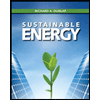
Bundle: Sustainable Energy, 2nd + Mindtap Engineering, 1 Term (6 Months) Printed Access Card
2nd Edition
ISBN: 9781337896535
Author: Richard A. Dunlap
Publisher: Cengage Learning
expand_more
expand_more
format_list_bulleted
Question
Chapter 9, Problem 13P
To determine
Find the maximum acceptable installation cost.
Expert Solution & Answer
Want to see the full answer?
Check out a sample textbook solution
Students have asked these similar questions
The annual average insolation for a fixed solar panel in
city A is 350 W/m2. On the other hand, city B has a figure
of 300 W/m?. For both locations, the solar panel has the
capability to convert 17% of the incident energy into
electricity. Average annual electricity in City A is 13 000
kWh with an average cost of $0.4/kWh, while in city B, it
is 10 000 kWh at a cost of $0.75/kWh.
For City A,
a. Determine the area of the solar panel needed in order
to suffice the average electrical needs of a residence.
b. Determine the area of the solar panel needed in order
to suffice the average electrical needs of a residence in
City B.
c. Determine the price per square meter of solar panel in
City A if the device has a lifetime of 20 years. Assume
that the electricity costs are constant throughout the
period.
d. Determine the price per square meter of solar panel in
City B if the device has a lifetime of 20 years. Assume
that the electricity costs are constant throughout the
period.
Q1: What is the primary process of converting solar energy
into other form of energy,
explain and give an example of each one of them?
Q2: Determine the Sun's altitude angle , azimuth angle, and
zenith angle at 5.00 P.M on
December 15, 2017 for a location at 24.85° N latitude.
Q3: Compare the power generated by the two shown systems
1 and 2, if each turbine have
air velocity in that area was V= 5 m/sec and the air density
p=1.19 kg/m³m while in system 2 to increase the air velocity
we uses a truncated cone of area ration A1/A2=4.
blades 5 m length, while the
On a summer day, the mean solar irradiance received at a lake was 500 W/m^ 2 over 25 days (consider the day length to be 8 hours). If 80% of the energy is used to vaporize water, how large could the depth of evaporation be?
Chapter 9 Solutions
Bundle: Sustainable Energy, 2nd + Mindtap Engineering, 1 Term (6 Months) Printed Access Card
Knowledge Booster
Similar questions
- A 2 x 2 m flat plate solar collector for domestic hot water heating is shown in the figure. The incident solar radiation on the glass cover, which transmits 90% of the incident flux, is 750 W/m2. Water flows through the tubes soldered to the backside of the absorber plate, entering at a temperature of 25°C. The temperature of the glass cover is 27°C, and it radiates heat with an emissivity of 0.92 to the sky at –50°C. Additionally, the glass cover losses heat by convection to air at 20°C flowing over its surface at 30 km/h. Assume that the radiation heat transfer between the absorber plate and glass cover and the heat transfer through the back and sides of the collector is negligible.arrow_forwardFor a building located in Madrid, Spain with annual heating degree-days (dd) of 4654, a heating load (heat loss) of 30,000 kj/h, and a design temperature difference of 30° C (20° C indoor), estimate the annual energy consumption. If the building is heated with a furnace with an efficiency of 92%, how muchgas is burned to keep the home at 20° C? State your assumptions.arrow_forwardWhen 1 cu ft of natural gas is burned, 1,050 Btu of heat are produced. In oneday, a building uses 761,250 Btu of heat. How many cubic feet of gas areburned?arrow_forward
arrow_back_ios
arrow_forward_ios
Recommended textbooks for you

 Sustainable EnergyCivil EngineeringISBN:9781133108689Author:Richard A. DunlapPublisher:Cengage Learning
Sustainable EnergyCivil EngineeringISBN:9781133108689Author:Richard A. DunlapPublisher:Cengage Learning Engineering Fundamentals: An Introduction to Engi...Civil EngineeringISBN:9781305084766Author:Saeed MoaveniPublisher:Cengage Learning
Engineering Fundamentals: An Introduction to Engi...Civil EngineeringISBN:9781305084766Author:Saeed MoaveniPublisher:Cengage Learning


Sustainable Energy
Civil Engineering
ISBN:9781133108689
Author:Richard A. Dunlap
Publisher:Cengage Learning

Engineering Fundamentals: An Introduction to Engi...
Civil Engineering
ISBN:9781305084766
Author:Saeed Moaveni
Publisher:Cengage Learning